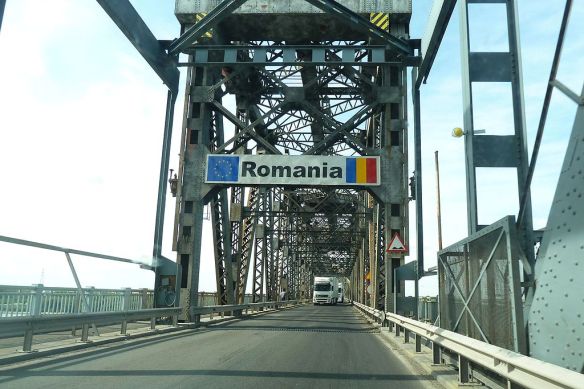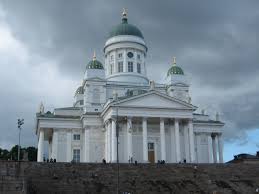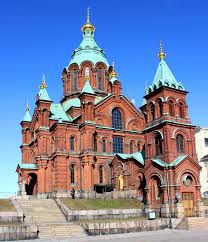This is my second visit to Bulgaria in quick succession after a very successful trip to Sofia and Shumen last September. Thus far this particular break in the city of Ruse, on the Romanian border in the north-east and overlooking the Danube, has been an unqualified success. Once again, however, I have found myself instinctively comparing Bulgaria to Finland on numerous counts. How can it be that one country invites parallels with one in such a different geographic (and climactic) part of Europe? Time for a point-by-point checklist, I guess.
1) They’re both at a geographic and cultural crossroads, not quite easily definable within a bloc of countries or states and yet sharing similarities with all the countries around them. Finland is certainly one of the Nordic countries, but there is an age-old debate about whether it is part of Scandinavia per se. The border with, and certain cultural affinities with, Russia underline this particular point; I remember once reading that Helsinki had the best Russian restaurants in the world prior to the end of the Cold War. And yet it’s a country where Swedish is the second language and where Estonia, with its highly similar language, is a quick (and often drink-fuelled) hydrofoil ride away.
Same can be said for Bulgaria. A bit too far south to be solidly within Eastern Europe. Plenty of Turkish heritage courtesy of centuries of Ottoman rule, but independent since the early 20th century (rather like Finland freeing itself from Russian rule at more or less exactly the same time). Cuisine similar to Greece and Romania, but no shared alphabet with either neighbour. The sense of other-wordliness has seemed more potent to me since I’ve been in Ruse; I’m sure I read somewhere that Romania seems like a distant and nebulous entity to many residents here rather than somewhere just over the river. On a personal level, this has been compounded for me by the fact that in the stifling summer heat, it becomes problematic trying to move any significant amount of distance in the city (never mind towards the 1950s Danube Bridge that takes you into, or out of, Romania).
2) Historical religious diversity. In a modern context, we’re used to the idea in post-Cold War multicultural metropolitan centres within Europe; in a historical context, we’re also used to the idea with regards to places in the Middle East such as Jerusalem and Beirut. But how about the Orthodox cathedral on Helsinki waterfront standing only a few hundred metres from the Lutheran cathedral, and both of them being very visually distinctive and prominent? That’s on a par with the historical mosque in Sofia standing close to the Sveta Nedelya church right in the centre of the city. The funny parallel in both instances is that this religious diversity in these two countries is easily overlooked (I’ve been as guilty of it in my time as anyone else) and yet seems perfectly understandable when one is in the countries themselves and sees the buildings close up. Well, that’s my experience at least.
3) Great folk music that doesn’t fit in anywhere else. Except (maybe, just maybe) in the other country. We’ve written our love letter to Finnish folk legends Värttinä here before, but their piercing, haunting, idiosyncratic vocal melodies are so, so redolent of the renowned Le Mystère des Voix Bulgares recordings. In the same way that Värttinä randomly and effortlessly deploy all sorts of time signatures, so I remember first seeing folk music in that far-from-familiar 9/16 rhythm, courtesy of the Bulgarian tune Diacove. Maybe that’s Bulgarian music for you: I’ve spent the best part of a year listening to a CD by the Bulgarian National Radio Folk Orchestra and dividing my time between trying to work out the melodies and trying to work out the rhythms.
4) Sudden unexpected outbreaks of easy listening music. When I was in Tampere in late June 2010 and took a boat trip to the nearby island of Viikinsaari, I thought that the Midsummer celebrations would be defined by all that idiosyncratic folk music about which I have eulogised. Instead of which we got some very nice (but relatively low-key) waltzes played a bloke with a synthesizer. Ditto being in outstanding and thoroughly authentic (in terms of local cuisine) restaurants in Shumen and Ruse this year and last, where Bulgarian-language versions of I Just Called To Say I Love You (and some standard English-language pop covers) by a similar keyboardist/guitarist were par for the course.
Schmalzy? Well, actually, no; what was endearing on both occasions was a) the fact the musicians were making a concerted effort to entertain; b) the local contingent really enjoyed it. There’s something to be said for people actually getting up and doing old-style waltzes to the waltzes that are being played, as happened in Tampere that day. Maybe this thing does take place all over the world, but in all my years of travelling, it has seemed most conspicuous in these two countries. If, in its own way, it’s a genuine part of authentic local culture, well, why not?
5) Fab and completely underrated food. It’s not so long since former French president Jacques Chirac made some well-publicised (and snooty) comments about Finnish cuisine, but I’m reaching the point where I think the meals I had which were made with the most loving deliberation and care were in these two particular countries.
To quote an example from Finland, at Midsummer 2003 I feasted on fried whiting, game sausage and, to finish off, soft white cheese with cloudberry jam and cinnamon cream in a Lapp restaurant in Helsinki. In particular, the dessert was a really fine-tuned balancing act. I have always found cloudberry jam hardcore, a collision of sweet and sour that necessitates being doled out, and being complemented by exactly the right other foodstuffs, in exactly the right amounts. Job done that day: just a dab of jam, a modest square of cheese and a thin, but telling layer of spice-speckled cream to create a balancing act that seemed worthy of culinary Taoism (but for the fact that would involve Yin, Yang and Something Else).
Same goes for just about all the meals I have had in Bulgaria. The fish soup we have had more or less every night here in Ruse has (probably) got better by the night. What has been really impressive is the way the accompanying veg in the soup (potatoes, peppers, carrot) has been prepared. I thought crinkle-cut spuds only existed in the relatively unclassy frozen chip format, but here the potatoes are both cut into smaller, cube-like pieces and crinkle-cut and possibly cooked in (at least) two different ways as well; they taste as if they’ve somehow been marinaded (is that possible?), parboiled and parfried without turning into a dissolute mess or a skyscraper of carby greasiness in the process. Next to the fresh Danube fish in the soup, they take on a diaphanous, even silky, quality for the common spud that is both both unexpected and pleasing.
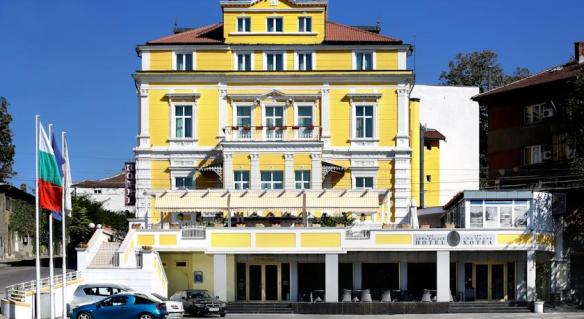
The Hotel Anna Palace, Ruse. Where I have stayed and dined this week. Now compare and contrast with image below
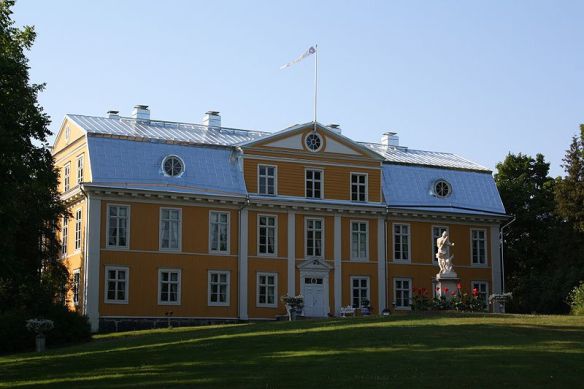
Mustion Linna, Finland. See those yellow neo-classical, neo-Rococo architectural and aesthetic similarities coming to the fore
It’s not clear to me at this point what, if any, specific recipes might be common to both countries: maybe the access to high-quality, locally-sourced meat, fish, veg and grain in two agriculturally potent and relatively under-industrialised countries is a more telling common denominator than any particular recipe or recipes. What has been obvious in both countries is a sense of quiet, unshakeable pride and courteousness among those who have served the food.
Upon leaving Helsinki on that 2003 trip, I had apple cake and rhubarb and strawberry cake at the airport cafe. Both cakes were incredibly good; I told my work colleague (and fellow foodie) about them upon returning to England, and he articulated what I hadn’t managed to (possibly out of surprise) since returning: that they may well have been home-made and brought in by the cafe staff. I think my surprise was compounded (at the time) by the fact that the girl at the pay till smiled serenely and said: ‘Would you like some vanilla sauce?’ She was wearing a crisp blue and white dress that could have indeed passed for a variant on traditional national costume. The contrast with buying cellophane-wrapped, additive-aspyhixiated, overpriced crap from a flustered, underpaid staff member at a classic faceless customers-on-a-conveyor-belt chain outlet in an equally faceless airport terminal in certain other countries could not have been starker.
I have been reminded of that dignity and downright niceness this week when being waited on at the hotel restaurant. Normally I have eaten soup and then shared some salad and a traditional Bulgarian dish with my other half, and finished off (the savoury courses at least) with a modest amount of meat, just for the variety of taste as much as anything else. It is possible to order a cut of meat and no side dishes here: a concept probably more familiar to British greasy spoon ‘make your own breakfast’ cafes than it is to British restaurants, not for any good reason (that’s my polite way of saying I would like to see more of this at home, and at competitive prices).
Anyway. One night this week, I ordered a meatball. The waiter frowned a little, then smiled serenely and confidentially himself. ‘Really,’ he said. ‘You should have more than one. It’s the taste.’
He was right. Quality and quantity did converge. They were sumptuous, charred, herb-laden mini-burgers of sorts. In the plural. Because I did have more than one. Just as I had the vanilla sauce in Helsinki eleven years previously.

